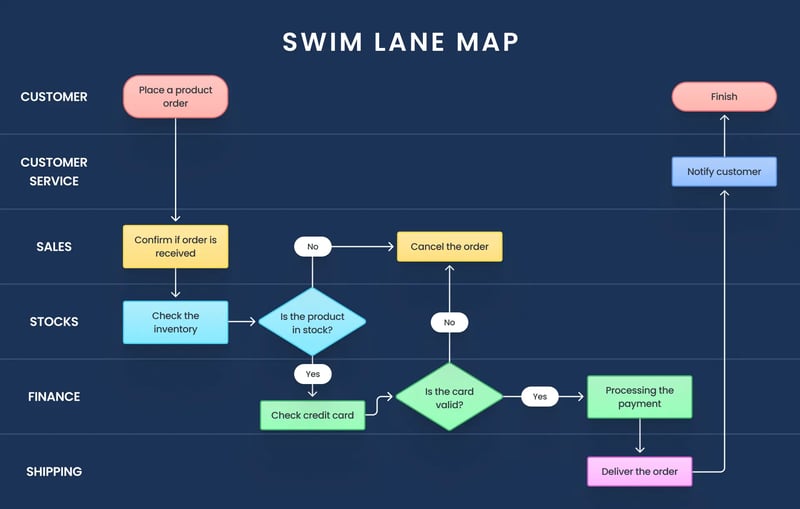Dive into Efficiency with Swim Lane Process Map: A Comprehensive Guide
In today's fast-paced and interconnected world, businesses and organizations are constantly seeking ways to improve efficiency and optimize their processes. Against this backdrop of pressure, discover with us one powerful tool that can help achieve these goals: the swim lane map. A swim lane map is a visual representation of a workflow that displays the steps, activities, and responsibilities of different individuals or departments involved in a process. Join us, we will show you a comprehensive guide to explore the concept of swim lane maps, their benefits, and how to create effective swim lane maps to streamline your workflows.
What will you find in this article?
- Understanding Swim Lane Process Maps
- Creating an Effective Swim Lane Process Map
- Tips for Creating an Effective Swim Lane Process Map
- FAQs
- Powerful tools to enhance processes
Understanding Swim Lane Process Maps
What is a Swim Lane Process Map?
Let's start small. First, we need to clarify concepts. A swim lane process map, also known as a cross-functional flowchart or a process map, is a visual representation of a process that shows the various steps, activities, and departments or individuals involved. It organizes information in lanes or columns, assigning each lane to a specific role or department, making it easier to understand and analyze the flow of work.
Why are Swim Lane Process Maps Useful?
- Enhanced Process Visibility: Swim lane process maps provide a clear and comprehensive overview of a process, making it easier to identify bottlenecks, redundancies, and areas for improvement in any company.
- Improved Collaboration: By visualizing the responsibilities and handoffs between different departments or individuals, swim lane maps promote collaboration and help streamline communication.
- Efficient Problem Solving: Swim lane maps enable teams to identify and address process inefficiencies, leading to improved productivity and customer satisfaction.
Creating an Effective Swim Lane Process Map
Perfect, now we are clear on the concepts! Next, let's see how you can easily set up a swim lane process map from scratch in your department.
Identify the Process to Map
- Choose a specific process that you want to map, such as a sales order fulfilment process or a customer support workflow.
- Clearly define the start and end points of the process to ensure a focused and comprehensive swim lane map.
Determine the Lanes and Participants
- Identify the key departments, teams, or individuals involved in the process.
- Assign each participant to a dedicated lane in the swim lane map.
Map the Process Steps
- Break down the process into its sequential steps, and list them horizontally across the swim lane map.
- Place the steps within the appropriate lanes based on the department or individual responsible for each step.
Add Decision Points and Handoffs
- Identify decision points in the process where different paths may be taken or decisions need to be made.
- Clearly indicate handoffs between departments or individuals, ensuring a smooth workflow.
Tips for Creating an Effective Swim Lane Process Map
OK, four steps that seem pretty clear. But what are the recommendations we would give to any team that wants to create a swim lane process Map in the most effective way? It all comes down to gaining experience, testing, standardising and always looking for feedback that will make us improve.
Keep It Simple
- Avoid overcrowding the swim lane map with unnecessary details. Focus on the key steps and responsibilities.
- Use clear and concise labels and symbols to represent activities and participants.
Use Standardized Symbols and Icons
- Utilize universally recognized symbols and icons to enhance clarity and understanding.
- Consistent usage of symbols ensures easier interpretation and reduces confusion.
Collaborate and Seek Feedback
- Involve all relevant stakeholders during the creation process to ensure accuracy and completeness.
- Gather feedback and make revisions as necessary to create a refined and effective swim lane map.
FAQ
How can swim lane maps benefit my organization?
Swim lane maps provide process visibility, promote collaboration, and enable efficient problem-solving, leading to improved efficiency and productivity.
Are swim lane maps suitable for all types of processes?
Yes, swim lane maps can be used to map and optimize various types of processes, regardless of the industry or sector.
Powerful tools to enhance processes
Wow! That went fast. If you've read this far, you already know that swim lane maps are powerful visual tools that enable organizations to gain insights into their processes, enhance collaboration, and improve efficiency. By clearly mapping out workflows and responsibilities, swim lane maps help identify bottlenecks and areas for improvement, leading to streamlined operations and better outcomes.
You should know that at Bigle Legal we are experts in the automation and efficiency of legal operations. We are also experts in process mapping and provide customised consultancy in this respect, in conjunction with our excellent Contract Lifecycle Management (CLM) platform. Do you want to know more about us? Or are you looking for personalised advice? Don't hesitate to contact us!
Now that you have a comprehensive understanding of swim lane maps, it's time to dive in and leverage their benefits to optimize your organization's workflow management. Start creating effective swim lane maps and unlock the potential for enhanced productivity and success.
 By
By




